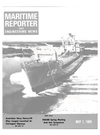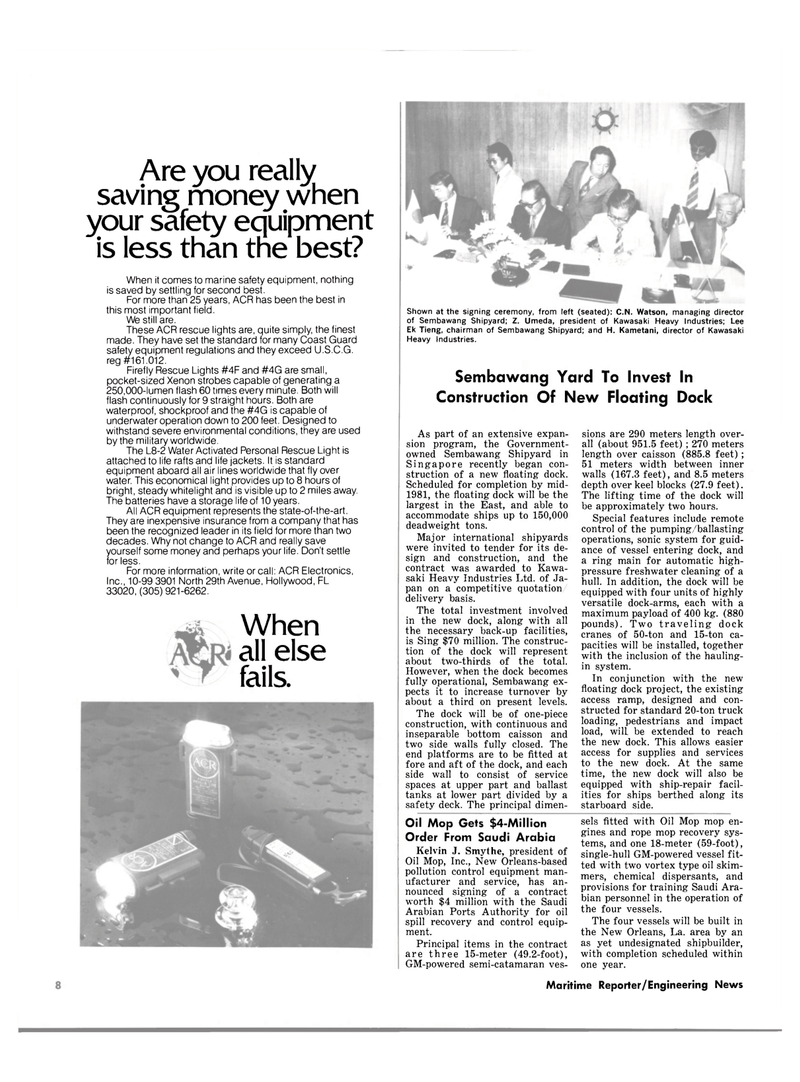
Page 6: of Maritime Reporter Magazine (May 1980)
Read this page in Pdf, Flash or Html5 edition of May 1980 Maritime Reporter Magazine
Are you really saving money when your safety equipment is less than the best?
When it comes to marine safety equipment, nothing is saved by settling for second best.
For more than 25 years, ACR has been the best in this most important field.
We still are.
These ACR rescue lights are, quite simply, the finest made. They have set the standard for many Coast Guard safety equipment regulations and they exceed U.S.C.G. reg #161.012.
Firefly Rescue Lights #4F and #4G are small, pocket-sized Xenon strobes capable of generating a 250,000-lumen flash 60 times every minute. Both will flash continuously for 9 straight hours. Both are waterproof, shockproof and the #4G is capable of underwater operation down to 200 feet. Designed to withstand severe environmental conditions, they are used by the military worldwide.
The L8-2 Water Activated Personal Rescue Light is attached to life rafts and life jackets. It is standard equipment aboard all air lines worldwide that fly over water. This economical light provides up to 8 hours of bright, steady whitelight and is visible up to 2 miles away.
The batteries have a storage life of 10 years.
All ACR equipment represents the state-of-the-art.
They are inexpensive insurance from a company that has been the recognized leader in its field for more than two decades. Why not change to ACR and really save yourself some money and perhaps your life. Don't settle for less.
For more information, write or call: ACR Electronics,
Inc., 10-99 3901 North 29th Avenue, Hollywood, FL 33020, (305) 921-6262.
When all else fails.
Shown at the signing ceremony, from left (seated): C.N. Watson, managing director of Sembawang Shipyard; Z. Umeda, president of Kawasaki Heavy Industries; Lee
Ek Tieng, chairman of Sembawang Shipyard; and H. Kametani, director of Kawasaki
Heavy Industries.
Sembawang Yard To Invest In
Construction Of New Floating Dock
As part of an extensive expan- sion program, the Government- owned Sembawang Shipyard in
Singapore recently began con- struction of a new floating dock.
Scheduled for completion by mid- 1981, the floating dock will be the largest in the East, and able to accommodate ships up to 150,000 deadweight tons.
Major international shipyards were invited to tender for its de- sign and construction, and the contract was awarded to Kawa- saki Heavy Industries Ltd. of Ja- pan on a competitive quotation delivery basis.
The total investment involved in the new dock, along with all the necessary back-up facilities, is Sing $70 million. The construc- tion of the dock will represent about two-thirds of the total.
However, when the dock becomes fully operational, Sembawang ex- pects it to increase turnover by about a third on present levels.
The dock will be of one-piece construction, with continuous and inseparable bottom caisson and two side walls fully closed. The end platforms are to be fitted at fore and aft of the dock, and each side wall to consist of service spaces at upper part and ballast tanks at lower part divided by a safety deck. The principal dimen- sions are 290 meters length over- all (about 951.5 feet) ; 270 meters length over caisson (885.8 feet) ; 51 meters width between inner walls (167.3 feet), and 8.5 meters depth over keel blocks (27.9 feet).
The lifting time of the dock will be approximately two hours.
Special features include remote control of the pumping/ballasting operations, sonic system for guid- ance of vessel entering dock, and a ring main for automatic high- pressure freshwater cleaning of a hull. In addition, the dock will be equipped with four units of highly versatile dock-arms, each with a maximum payload of 400 kg. (880 pounds). Two traveling dock cranes of 50-ton and 15-ton ca- pacities will be installed, together with the inclusion of the hauling- in system.
In conjunction with the new floating dock project, the existing access ramp, designed and con- structed for standard 20-ton truck loading, pedestrians and impact load, wilL be extended to reach the new dock. This allows easier access for supplies and services to the new dock. At the same time, the new dock will also be equipped with ship-repair facil- ities for ships berthed along its starboard side.
Oil Mop Gets $4-Million
Order From Saudi Arabia
Kelvin J. Smythe, president of
Oil Mop, Inc., New Orleans-based pollution control equipment man- ufacturer and service, has an- nounced signing of a contract worth $4 million with the Saudi
Arabian Ports Authority for oil spill recovery and control equip- ment.
Principal items in the contract are three 15-meter (49.2-foot),
GM-powered semi-catamaran ves- sels fitted with Oil Mop mop en- gines and rope mop recovery sys- tems, and one 18-meter (59-foot), single-hull GM-powered vessel fit- ted with two vortex type oil skim- mers, chemical dispersants, and provisions for training Saudi Ara- bian personnel in the operation of the four vessels.
The four vessels will be built in the New Orleans, La. area by an as yet undesignated shipbuilder, with completion scheduled within one year. 10 Maritime Reporter/Engineering News

 5
5

 7
7
